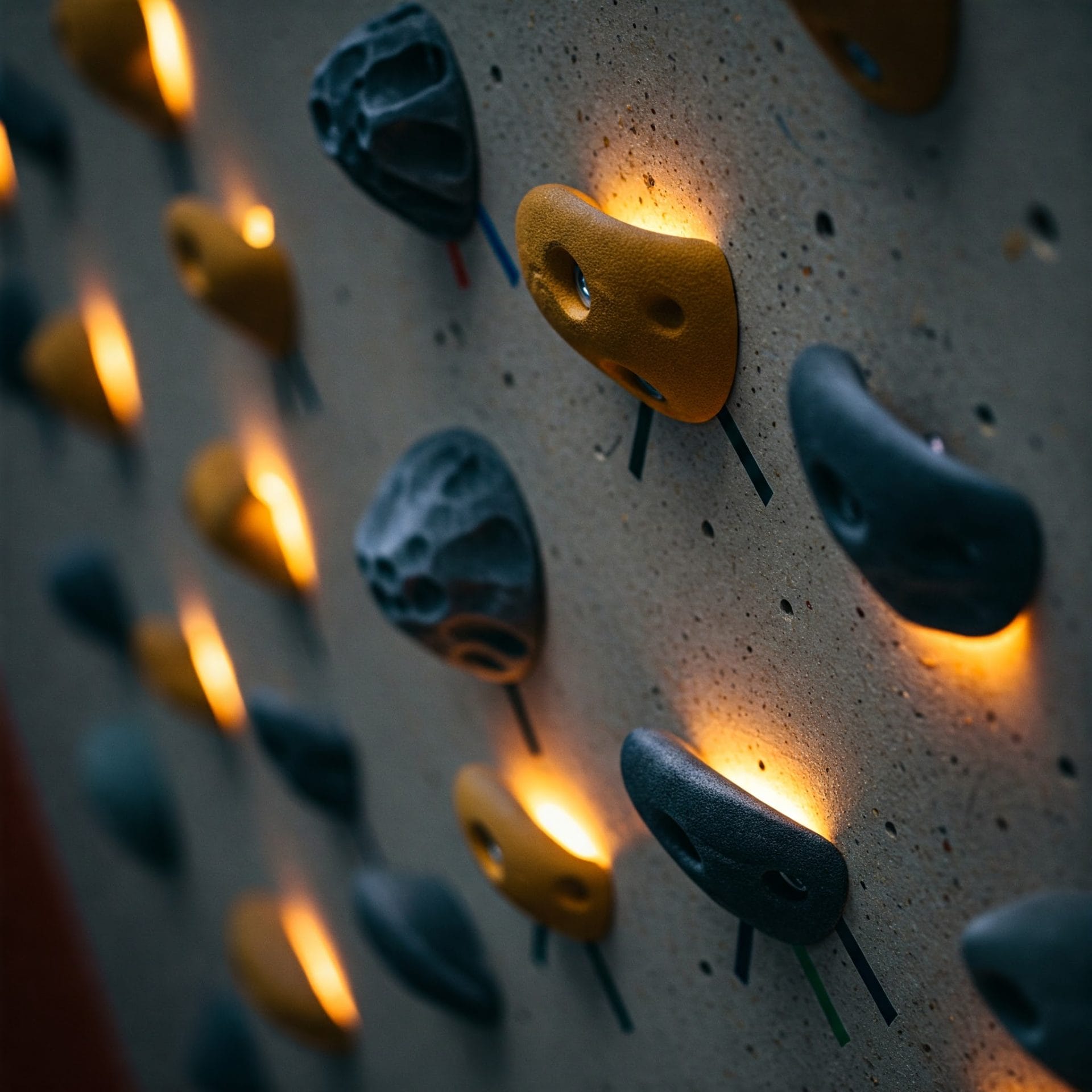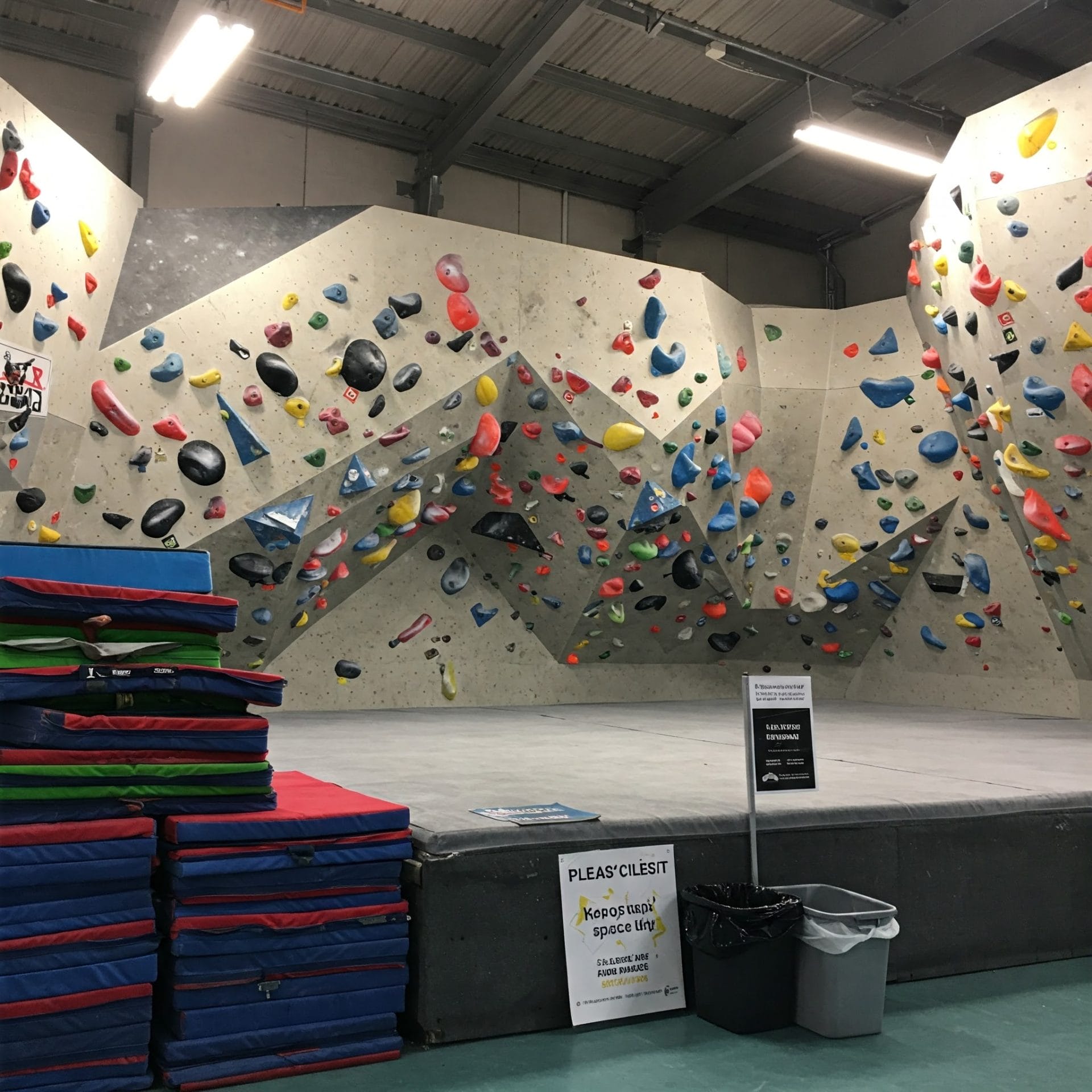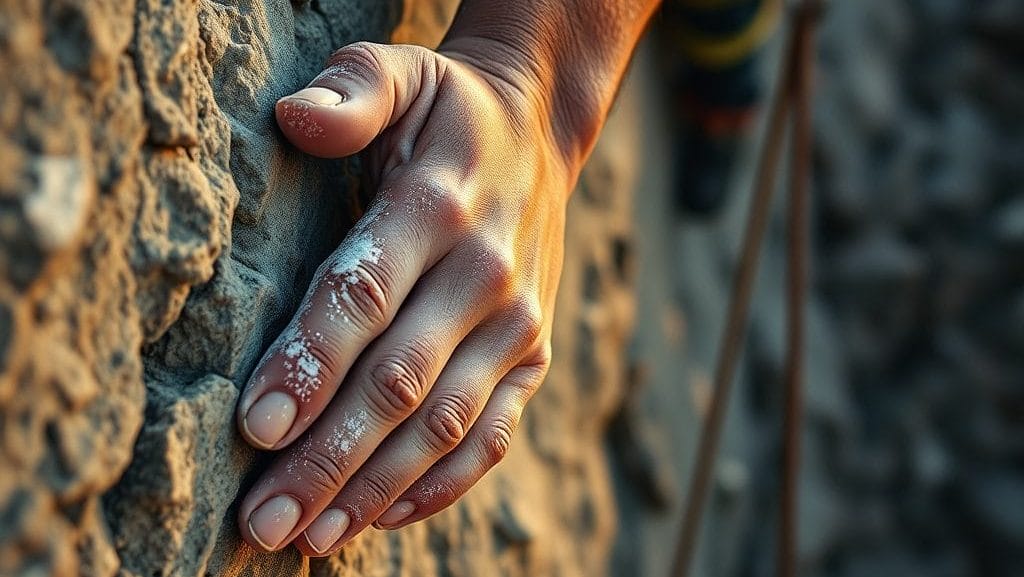Explore the essential bouldering terms to communicate better and enhance your climbing adventures.
Bouldering vocabulary opens up a world of precise movement descriptions and safety communication at the climbing gym. From basic terms like “crimps” (small finger holds) to advanced beta calls such as “gaston” (an outward-facing grip position), these words form the essential language of climbing. The climbing community uses this shared terminology to describe routes, movements, and techniques across all skill levels.
Understanding these terms helps climbers progress faster, communicate better with partners, and grasp movement concepts more effectively. This guide breaks down common bouldering terms that every climber needs to know. (1)
Key Takeaway
- Bouldering has its own special words that help climbers communicate.
- Knowing these terms can make climbing safer and more fun.
- You can find many resources online to learn more about bouldering.
What Is Bouldering?
Bouldering is a type of rock climbing. It usually happens on shorter walls and boulders. Climbers don’t use ropes. Instead, they jump down onto soft mats called bouldering pads. This makes it safer if they fall. Bouldering is fun, but to enjoy it, you need to know some important words.
Key Terms in Bouldering
Credit:By Catalyst Climbing
Bouldering is a sport, a challenge, and an art form. It’s not just about scaling a wall, but about how you approach it. Style plays a huge role in bouldering.
- Movement and technique: Bouldering is about fluidity—how your body moves, how you engage with holds. Great climbers make tough problems look effortless.
- Finesse over force: The best climbers conserve energy, placing feet just right and using minimal strength.
- Mental approach: Style is personal. Some rely on brute force, others on calculated patience. Both are valid, but it’s the balance that defines a climber’s style.
- The culture: Climbers talk about their style—whether it’s strength, strategy, or finesse. The way you approach a problem adds meaning to your success.
In bouldering, style is key. It’s about solving the puzzle with the perfect technique and mindset, not just finishing the climb.(2)
Arete
The sharp, jagged rock face looked impossible to climb. An arête is a narrow, exposed ridge formed where two rock faces meet. Climbers use it to ascend mountains, though it’s like walking a high wire.
- The ridge is only a few feet across, but with steep drops on either side.
- Climbing it requires a steady, focused balance and strength.
- Every muscle is engaged, and it’s physically demanding.
- You use both hands and feet to steady yourself, sometimes scrambling for holds.
- Arêtes can vary in length, from short obstacles to miles-long ridges.
It’s a test of endurance and precision. Experienced climbers often approach it like a puzzle, taking each movement slowly. The key is strategy, not brute strength. Always focus on balance, use your whole body, and take your time.
Bouldering Pad
Bouldering pads are essential safety tools in a climber’s kit, designed to protect against falls that might otherwise result in injury. Here’s why they matter:
- Function: They cushion falls, preventing significant injury from even small heights, like a 10-foot fall.
- Size and Design: Pads are typically 40–50 inches wide, 3–5 inches thick, and may fold for portability.
- Material: Most use a combination of EVA foam (stiff, durable) on top and PU foam (softer) underneath to absorb shock and reduce bruises.
- Protection: They distribute impact force, protecting areas like ankles and knees.
- Additional Features: Some pads offer adjustable straps and extra foam layers for added safety.
A good pad makes the difference between a sore muscle and a serious injury. If you boulder, don’t skimp—invest in quality padding for maximum safety. Always bring an extra pad when possible.
Dyno
The dyno is an iconic climbing move that involves a leap to catch a distant hold. Here’s what makes it unique:
- Intensity: Unlike steady moves, dynos require a quick burst of power.
- Physics: The legs generate lift, and arms direct the jump toward the next hold.
- Reach and Force: The further the distance, the more power needed from the legs. You may need to generate two to three times your body weight in force.
- Body Position: Mid-air adjustments may be necessary to make the catch.
- Mental Focus: Clear mental images of the hold and quick reactions are key.
- Confidence: Hesitation can cost the move. Trusting your body is crucial.
- Training: Plyometric exercises, like box jumps, and strong core work can boost performance.
The dyno combines physical strength with mental clarity, creating a thrilling challenge that requires practice and confidence to master.
Crimp
Crimps are notorious for making your fingers scream for mercy after just a few seconds. These tiny holds look laughable to beginners, but they demand something no other hold does. When you reach for a crimp, you’re not just pulling with your fingers—your whole hand locks into place to maintain the smallest hold possible.
Key points to consider:
- Crimps use minimal contact points, usually just the fingertips.
- Strong finger flexors and tendons are essential for this grip.
- Incorrect technique can lead to finger injuries or tendon strains.
- A good crimp involves the thumb pressing down on the index and middle fingers, creating a pinch.
- Smaller crimps demand even more finger strength and technique.
Training for crimps often involves fingerboard exercises. It’s important to build strength gradually to avoid injury. Though crimps are tough, being prepared with finger exercises can help handle these holds better in the future.
Jug
The jug hold is a climber’s dream, offering strength and precision. It’s large, like a basketball, shaped to fit a human hand. When climbing, jugs provide relief—your fingers stretch and relax on their smooth surface.
- Jugs are forgiving, reducing stress on your fingers and joints by distributing weight evenly.
- Climbers often seek them for long ascents, especially on tough, overhung sections.
- They range in size from 3 to 8 inches, with smooth or jagged textures.
While jugs seem easy, technique still matters.
- Keep your wrist straight and relaxed.
- Use your body to push, not just your arms.
- Avoid over-gripping and clean the hold if necessary.
Though jugs are reliable, don’t underestimate the need for solid footwork and body alignment. A jug might be a relief, but it won’t save you if you’re not in the right position.
Mantel
When climbing, strength alone isn’t enough to get past tricky sections. The mantel move stands out as a key technique in conquering ledges. It combines balance, coordination, and finesse.
The mantel starts with proper positioning:
- Feet: Place them close to the ledge, ideally high, to help push yourself up.
- Hands: Position them just above the lip for support and to assist in lifting your body.
The move relies on momentum. Use your legs more than your arms, as they’re stronger. Press with your feet, pull with your arms, and find the right balance to avoid exhaustion. In some cases, rock type (sandstone vs. granite) affects grip.
To succeed:
- Shift body weight to gain that extra push.
- Stay calm and focused.
- Rely less on your arms and more on your legs.
With practice, the mantel becomes second nature.
Sit Start
When watching a climber start a bouldering climb from a seated position, it’s like watching a cat ready to pounce. They settle into a low squat, hands gripping holds just above their head, feet flat on the wall. The moment their muscles tense, you know they’re about to launch.
Sit starts challenge climbers differently from standing starts.
- Leg Position: Feet should be below your hips, around 12–18 inches from the ground, with bent knees to load leg muscles.
- Core Engagement: Keep your core tight to avoid wobbling as you launch.
- Push and Pull: Push through your legs while using your arms to help pull yourself up.
- Upper Body Strength: Your arms need to stay controlled as you reach for higher holds.
Sit starts force climbers to refine technique, especially lower body and core stability. While frustrating at first, mastering the sit start can make you feel stronger, more stable, and ultimately more confident.
V Grade
The first time they tried the V3 problem, it felt like someone had made a mistake.
- The holds were slicker than expected, like someone had greased them up.
- The crimps were so tiny, it felt like trying to grip a pencil with just the tips of your fingers.
- They weren’t sure if their arms would give out or if they’d slip off the wall entirely.
After a break, they realized the V-grade system wasn’t a joke—it was a tool for climbers to understand the difficulty of a problem.
- The system starts at V0 (beginner) and goes up to V17 (extreme challenges).
- Higher V-grades demand strength, technique, and mental focus.
- Different gyms may grade problems differently, but the system helps climbers communicate difficulty.
Climbing isn’t just about strength—it’s about problem-solving and endurance. Keep pushing and enjoy the climb, even if the V-grade feels off at times.
Other Important Concepts
Bouldering is more than just climbing; it’s like a personal conversation with the rock. It’s demanding, raw, and utterly satisfying.
- Grip: Different grips require unique techniques. Crimps involve curling fingers around edges, creating tension. Slopers need a broader palm and more range of motion. Over time, your grip strength improves, but expect sore fingers.
- Footwork: Good footwork is key. Your feet do most of the work, but beginners often focus only on their hands. Proper foot placement helps with balance, saves energy, and reduces reliance on arms.
- Body Positioning: Bouldering is not just about strength. Push with your legs, engage your core, and focus on body positioning. This conserves energy and allows for longer climbs.
- Fall Safely: Falling happens, but land safely. Keep your body relaxed, land on your feet, and roll to absorb impact.
Start slow, build strength, and enjoy the process!
Spotting
Spotting in sports, especially weightlifting or gymnastics, is more than just standing by. It’s about providing safety when a lifter is at risk and guiding their descent to avoid injury.
- The Importance of Spotting: A good spotter can prevent accidents. For example, a lifter’s arms may tremble during a press, and the spotter helps guide the weight back down, avoiding injury.
- Proper Technique: Spotters need to be close but not too close. For squats, hands should be under the armpits, while for overhead presses, spotters guide the bar by the elbows.
- Communication: A spotter must understand body language—shaking, breath holding, or struggling. Quick reactions are essential when something goes wrong.
- Skill and Patience: Spotting requires strength, reflexes, and good judgment. Knowing when to step in and when to stay back is crucial for safety.
Top Out
The feeling of standing on top of a boulder after a tough climb is special. You’ve made it—heart racing, sweat dripping, but proud. It’s a moment of accomplishment.
- Topping out isn’t just about the final move.
- Balance, grip, and focus are essential.
- Every muscle—arms, legs, core—works in sync.
- The mind and body cooperate to achieve success.
Most boulders are 10 to 20 feet tall, but the difficulty matters more than the height. Some routes are tough, with small holds and tricky moves.
- Sore fingers and tired arms are part of the process.
- But reaching the top feels like victory, not just over the rock, but over self-doubt.
Climbing demands endurance and strength.
- Top-out moments make the effort worth it.
- Fatigue feels earned, dulled by the sense of accomplishment.
The key to improvement? Small, smart moves.
- Practice, relax your body, keep your mind sharp.
Traverse
A traverse is not your typical climb. Instead of going straight up, you move sideways across rock, boulders, or snowfields. The goal isn’t height, but lateral progress.
Here’s what makes it unique:
- Technique: Traversing involves balancing and bracing more than climbing upward.
- Increased Muscle Engagement: Arms, shoulders, and core are heavily involved in keeping you stable.
- Mental Focus: Unlike vertical climbing, you must assess your surroundings, choose the best path, and stay centered.
- Body Awareness: Staying aware of your body’s position is crucial.
- Risk Management: Terrain can be loose, and footing may be precarious, especially with drops below.
Tips for Beginners:
- Plan your route: Identify handholds and footholds.
- Stay low: Keep your center of gravity lower for better balance.
- Use your whole body: Engage your core and legs for stability.
- Rest: Take breaks when needed to avoid strain.
Resources to Learn More
If you want to learn even more about bouldering terms, there are great websites and blogs:
- MadBoulder Blog: This blog has a huge list of bouldering words, plus translations for climbers from all over the world.
- Lookout Mountain Conservancy: This site gives easy definitions for many bouldering terms.
- Three Rock Books: They have a long list of bouldering terms from a book called “Bouldering Essentials.” This book gives helpful tips for climbers.
Knowing these words can help you climb better and have more fun. Plus, it makes it easier to talk with other climbers. It’s like creating your own language!
Conclusion
Climbers at local gyms often encounter essential bouldering terms that shape their experience on the wall. “Beta” and “gaston” represent fundamental movements every climber needs to know. An arête, the sharp 90-degree outside corner of a wall, provides crucial holds during ascents. Meanwhile, a dyno requires both feet to leave the wall while jumping to the next hold. Understanding these terms through practice creates a more fluid climbing experience.
FAQ
What is bouldering?
Bouldering is a type of rock climbing that takes place on small rock formations or artificial rock walls, usually under 20 feet high. Climbers don’t use ropes or harnesses, relying instead on crash pads for safety. It focuses on strength, technique, and problem-solving to complete a route, also called a “problem.” Bouldering is popular because it’s accessible and allows climbers to practice their skills without needing a lot of gear or a partner.
What are the benefits of bouldering?
Bouldering offers many benefits, both physical and mental. It helps improve strength, flexibility, and balance while also enhancing problem-solving skills. Climbers develop better body awareness and coordination as they tackle different routes. Plus, bouldering can be a great way to relieve stress and connect with a community of like-minded individuals. Overall, it’s a fun and challenging workout that keeps you engaged and motivated.
What are the common terms used in bouldering?
In bouldering, you’ll encounter terms like “problems,” which refer to the routes you climb, and “crux,” the hardest part of a problem. “Beta” is the advice or tips on how to climb a specific route. You’ll also hear “mantle,” a move where you push down on a hold to get your body up and over it. Understanding these terms can enhance your climbing experience and help you communicate with other climbers.
What is the difference between bouldering and sport climbing?
Bouldering and sport climbing are both forms of climbing, but they have key differences. Bouldering involves climbing shorter walls without ropes, focusing on strength and technique. In contrast, sport climbing involves climbing taller routes with fixed anchors and a harness for safety. Both styles share skills and techniques, but bouldering is typically more intense and requires different problem-solving approaches due to the shorter, more powerful climbs.
What gear do I need for bouldering?
For bouldering, you don’t need much gear, making it quite accessible. The essentials include climbing shoes for better grip and a crash pad for safety when you fall. Some climbers also use chalk to keep their hands dry and improve grip. Optional gear can include a climbing brush to clean holds and a chalk bag for convenience. Overall, the gear is minimal compared to other climbing styles, allowing you to focus on the climb itself.
How can I improve my bouldering skills?
Improving your bouldering skills takes practice, patience, and a few strategies. First, focus on building your strength and flexibility through targeted workouts and stretches. Second, work on your technique by trying different problems and learning from others. Seek feedback and tips from more experienced climbers. Lastly, don’t forget to challenge yourself by attempting harder routes to push your limits and gain confidence in your abilities.
Is bouldering safe?
Bouldering can be safe when proper precautions are taken. Always use a crash pad to cushion falls and climb with a partner to help spot you. Make sure to choose problems that fit your skill level, and learn to fall safely by rolling or landing on your feet. While accidents can happen, being aware of your surroundings and applying safety measures can significantly reduce the risk of injury.
Can bouldering be done indoors?
Absolutely! Many climbing gyms have indoor bouldering walls designed for climbers of all skill levels. Indoor bouldering offers a controlled environment with a variety of challenges, allowing you to practice techniques and build strength year-round. It’s a great place to connect with other climbers, take classes, or just enjoy some fun exercise. Plus, you can enjoy bouldering regardless of the weather outside!
References
- https://www.substation.co.uk/blog/your-handy-glossary-to-bouldering-jargon
- https://lookoutmountainconservancy.org/bouldering-glossary/






